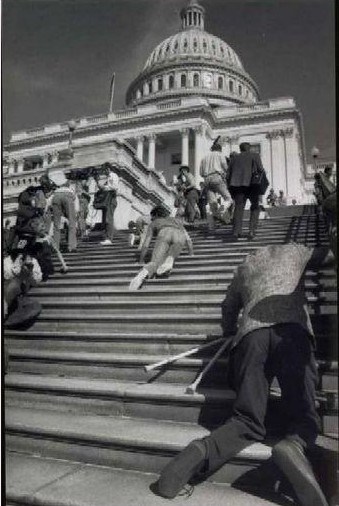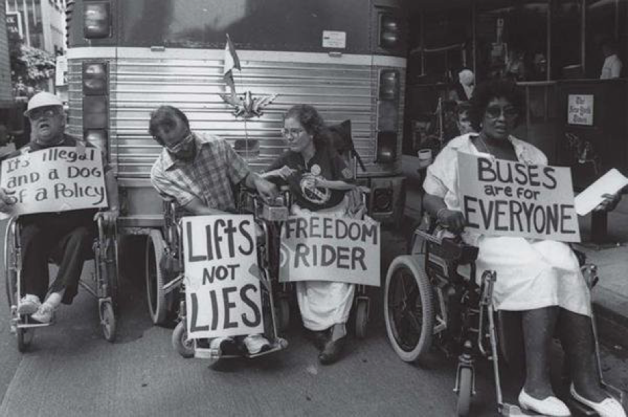As Fall approaches I look back at the commemoration of the 28th anniversary of the American with Disabilities Act with a mixture of pride and jubilation at how far we’ve come and frustration and anger that we still have a ways to go. Putting things into perspective, I know that many of my friends, colleagues and consumers would have faced a life of imprisonment in institutions were it not for those folks who refused to accept limitations in the 1960’s and 1970’s. These were the folks who put the bodies on the line in a struggle for Civil Rights; they chained themselves to inaccessible buses, and crawled up the US Capital steps to demand passage of the ADA. Even today this spirit burns on as people with disabilities have taken the lead in protecting essential health care coverage. I believe in the old saying that civil rights are never given to us, we have to struggle and fight to overcome outdated ideas and attitudes about people with disabilities. We can’t be complacent with our victories and our youth should know our history.


1989 Demonstration for ADA 1970’s Protests for Accessible Buses

Dragged from wheelchair and arrested at 2017 health care protest
So after all of these historic struggles where are we today?
EMPLOYMENT AND ECONOMIC DISCRIMINATION
The unemployment rate among people with disabilities hovers around 80% according to the US Bureau of Labor Statistics https://www.bls.gov/news.release/disabl.nr0.htm. Relying on benefits and being on a fixed income means that people with disabilities are more likely to be low income. In fact, the average income for a one person family with a disability in 2013 was $31,000 annually, in comparison, the income was $36,000 in 1990: the year the ADA was passed. http://disabilitystatistics.org/reports/cps.cfm?statistic=houseinc. How can we call that progress? The impact of this is particularly evident in the housing opportunities for people with disabilities. Research shows that in 2016 those with us who rely on SSI here in Westchester County would require 171% of our monthly income to afford a modest apartment.
OPPORTUNITIES TO REMAIN INDEPENDENT IN THE COMMUNITY
The above-noted economic conditions have resulted in barriers to community living. After incurring a disability a person is likely to experience a dramatic loss of income. Many people after a short hospital stay are sent for rehabilitation in a skilled nursing facility. When rehab is completed and discharge is imminent, finding housing that is both affordable and accessible is a formidable challenge. Soon the nursing facility takes all of your income making transition to the community even more difficult. The cost to Medicaid for nursing facility care is $9,000-12,000 per month. That’s a mighty expensive homeless shelter!
EDUCATIONAL OPPORTUNITIES
There remain barriers to higher education for people with significant disabilities. Back in the 1950’s Ed Roberts (A founding father of Independent Living Centers) was told that Vocational Rehabilitation would not fund his higher education because he was “unemployable”. He had the last laugh as 20 years later he became the California Commissioner of Vocational Rehabilitation. Education remains the key to productivity and breaking the strangle hold of poverty and lifting people with disabilities up. Thus the case of Nick Astor who was accepted to SUNY Purchase and right before the semester began, proper residential accommodations were not being made available. The discriminatory action by Purchase almost sabotaged this young man’s well developed plans. https://nyp.st/2LN8USk . While Purchase College and the family ultimately settled the matter: with the family and a government program sharing the cost of $10,000 for an additional room, I believe this only occurred because the students father had media and political connections. The average “Joan Jones” may not have had the same opportunity. The intent of the Americans with Disabilities Act is for institutions like Colleges to accommodate students with disabilities without additional costs. Unfortunately, since SUNY is a State College, New York State has “Sovereign Immunity”, meaning that the State cannot be sued under the ADA, unless it waives this immunity. WDOM and the New York Association on Independent Living have been advocating for legislation where NYS would waive the right. There must be no loopholes and/or exemptions to ADA compliance.
VOTING RIGHTS
Back in 2006 WDOMI and other organizations and individuals sued the County for failure to provide polling places that were accessible to people with disabilities or providing voting machines that could be independently operated by people with disabilities. That case was settled and the County improved polling site access with the input of the plaintiffs. Well its twelve years later and problems still exist. Equipment needed on Election Day to provide access often is neither properly delivered nor set up for use. While there is a devise to mark ballots for those who require accommodations, these devises are underutilized leading to elections workers who are not completely comfortable with its use. I personally vote on the ballot marking devise and when I arrive at my polling place the inspectors look like a deer in the headlights. I have waited for over 1 1/2 hours to cast my ballot, and I congratulated my poll workers in November 2017 when I got out in 15 minutes. The ultimate solution is that there has to be a single way to vote that will be accessible to all. We have learned that separate but equal is never really equal. At this year’s commemoration of the ADA we were lectured by an elections official that a single voting machine would never exist. He believes that such solution would discourage voting as it would take too long for the “average” voter. My response is to never stop trying. In the “Jim Crow” south of 1960, there were people who said that whites and African- Americans would never go to the same schools as white parents would send their children to private schools. We all know and should be proud about how that turned out.
MOVING FURTHER DOWN THE ROAD TO EQUAL RIGHTS
The examples of how we continue to experience discrimination show that we still have a ways to go to achieve a level playing field of opportunity for people with disabilities. As I approach 20 years at WDOMI and 35 years in the disability rights movement, I am well aware that I may not see a universally accessible society in my lifetime. So I say to my young friends, take the torch and lead on!